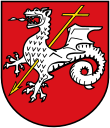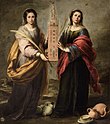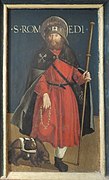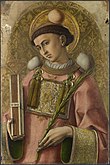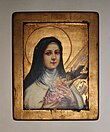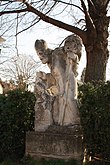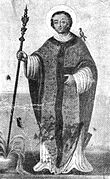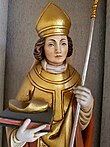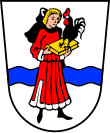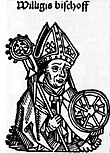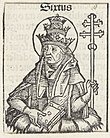Saint symbolism: Saints (Q–Z)
Saint symbolism has been used from the very beginnings of the religion.[1] Each saint is said to have led an exemplary life and symbols have been used to tell these stories throughout the history of the Church.[2] A number of Christian saints are traditionally represented by a symbol or iconic motif associated with their life, termed an attribute or emblem, to identify them. The study of these forms part of iconography in art history.[3] They were particularly used so that the illiterate could recognize a scene, and to give each of the Saints something of a personality in art.[2] They are often carried in the hand by the Saint.
Attributes often vary with either time or geography, especially between Eastern Christianity and the West. Orthodox images more often contained inscriptions with the names of saints, so the Eastern repertoire of attributes is generally smaller than the Western.[c] Many of the most prominent saints, like Saint Peter and Saint John the Evangelist can also be recognised by a distinctive facial type. Some attributes are general, such as the martyr's palm.[4] The use of a symbol in a work of art depicting a Saint reminds people who is being shown and of their story. The following is a list of some of these attributes.
Saints listed by name
[edit]Saints (A–H)
Saints (I–P)
Q
[edit]-
Saint Quentin with two spits
-
The arms of Roetgen showing the symbol of Quirinus, the patron saint of Rott, who killed a dragon with a crossed-spear
| Saint | Symbol |
|---|---|
| Quentin | two spits; vestments of a deacon; with a broken wheel; with a chair to which he is transfixed; with a sword or beheaded, a dove flying from his severed head[a][5] |
| Quiricus | naked child riding on a wild boar[a] |
| Quirinus of Malmedy | chasuble, dragon[6] |
| Quirinus of Neuss | military attire; knight with lance, sword, hawk; banner or sign with nine balls[a][7] |
| Quirinus of Sescia | millstone hanging from his neck[b][8] |
| Quirinus of Tegernsee | orb, scepter[9] |
| Quiteria | palm of martyrdom, with a dog on a lead, with her head in her hands, emerging from the sea[a] |
R
[edit]| Article title | Attributes |
|---|---|
| Rachilidis | Habit of a (Benedictine) hermit or anachoress[10] |
| Radegund | crowned; mantle with fleurs de lys[11] |
| Rafael Arnaiz Barón | Trappist habit[12] |
| Rafael Guízar y Valencia | Bishop's attire[13] |
| Rafaela Porras Ayllón | Religious habit of the Handmaids of the Sacred Heart of Jesus[14] |
| Randoald of Grandval | Monastic habit of a Benedictine, martyr's palm, spear[15] |
| Raphael (archangel) | holding a small package; walking with Tobias, carrying a fish; walking staff[b] |
| Rasso | military attire[16] |
| Raymond Nonnatus | Mercedarian religious habit, wearing a cardinal's red mozzetta, holding a monstrance and a martyr's palm[17] |
| Raymond of Capua | Dominican habit, holding the rule of the order[18] |
| Raymond of Penyafort | skimming across the sea with his cape as both boat and sail[19] |
| Raynald of Nocera | Bishop's attire over his Benedictine habit[20] |
| Regina (martyr) | depicted as experiencing the torments of martyrdom, or as receiving spiritual consolation in prison by a vision of a dove on a luminous cross.[21] |
| Reineldis | Religious habit with the staff and the headgear of a pilgrim, rosary, dragged by her hair in order to be decapitated[22] |
| Reinold | body armor, holding a shield, beaten to death with hammers[23] |
| Remaclus | Bishop's attire, accompanied by a wolf[24] |
| Remigius | dove, book, lamp[b] |
| Reparata | standing alone or near St. Mary, bearing a martyr's crown and palm; a dove; a banner with a red cross on a white field; sometimes depicted with St. Ansanus[25] |
| Restituta | pictured with an angel above her[26] |
| Reverianus | crozier, holding his mitred head in his hands[27] |
| Richardis | dressed in Imperial robes with crown and palm, and surrounded by flames; as well as a bear[28] |
| Richard | bishop with overturned chalice[a] |
| Rictrude | holding a model of a church[26] |
| Rieul of Senlis | frogs around him[26] |
| Rita of Cascia | roses, roses and figs, crucifix, thorn, robe of a widow or Augustinian habit sometimes with a wound or the marks of a thorn crown on her forehead[a] |
| Robert of Newminster | depicted as an abbot holding a church[26] |
| Roch | Wound on thigh (plague mark), dog offering bread, Pilgrim's hat, Pilgrim's staff, |
| Roger of Cannae | sheltered inder the wings of an eagle[29] |
| Rolando Rivi | cassock[30] |
| Romanos the Melodist | deacon's attire, standing on a raised platform in the middle of a church, holding a scroll with his Kontakion of the Nativity written on it. His icon is often a combined with that of The Protection of the Mother of God, which falls on the same day.[citation needed] |
| Romanus of Rouen | depicted with a Gargouille[26] |
| Romedius | alongside a packed bear[31] |
| Romulus of Fiesole | depicted with a wolf due to confusion with the legend of Romulus and Remus;[32] bishop with an arrow broken above his breast; depicted at martyrdom of 4 companions or enthroned among four martyrs[33] |
| Rosa Maria Benedetta Gattorno Custo | Nun's habit, crucifix, rosary, stigmata |
| Rosalia | roses, a cross, book, or skull, spray of lilies.[34] Some images show her holding a chisel and hammer with which she carved her own dedication. She is also seen wearing a crown of roses, attended by winged angels, and often with a view through a cave opening of Palermo Harbor.[citation needed], sometimes she is being crowned by the Divine infant[b] |
| Rose of Lima | crown of thorns, anchor, city, roses, crown of roses, sometimes wearing habit of the Dominican order [a], rosids |
| Rose of Viterbo | crown of roses, holding a crucifix[citation needed] |
| Róża Czacka | Religious habit[citation needed] |
| Rudolf Komórek | Cassock[citation needed] |
| Rufina and Justa | a model of the Giralda; earthenware pots, bowls and platters; books on which are two lumps of potter's clay; martyr's palm; lion[b], two maidens floating in the Tiber River with weights attached to their necks.[citation needed] |
| Rumbold of Mechelen | Bishop's attire with a missioner's cross[clarification needed], or with a hoe lying under his feet. He may also be shown murdered near a coffer of money[citation needed] |
| Rupert of Salzburg | Holding a container of salt; wearing clerical clothes including mitre; holding a crosier[citation needed] |
S
[edit]-
Saints Scholastica, Benedict and John the Evangelist
| Article title | Attributes |
|---|---|
| Sabbas the Sanctified | an apple in his hand[26] |
| Sabinian of Troyes | With Patroclus of Troyes; man with throat pierced by a sword; with Saint Sabina of Troyes[35] |
| Salome | vase of ointment[26] |
| Saturnin | bishop dragged by a bull[26] |
| Sativola | scythe, well[a] |
| Sava of Serbia | book[a] |
| Scholastica | habit of a Benedictine nun, dove, Rule of St. Benedict, crozier of an abbess[36] |
| Sebaldus | pilgrim with a staff; later represented with the model of a church[26] |
| Sebastian | Tied to a post, pillar or a tree, shot by arrows, crown[a] |
| Secundus of Asti | a sword; clouds overhead[26] |
| Septimius of Iesi | Episcopal attire[citation needed] |
| Serafino Morazzone | Priest's cassock[citation needed] |
| Seraphim of Sarov | Wearing peasant clothing, often kneeling with his hands upraised in prayer crucifix worn about his neck, hands crossed over chest[a] |
| Seraphin of Montegranaro | Franciscan habit[citation needed] |
| Serapion of Algiers | Palm branch, Mercedarian habit, Crucified in an x-position[citation needed] |
| Serenidus of Saulges | wearing a cardinal's habit and red galero[37] |
| Sergius and Bacchus | Roman soldiers bearing palm branches[26] |
| Sergius of Radonezh | Dressed as a monk, sometimes with paterissa[citation needed] |
| Servandus and Cermanus | Depicted as young soldiers[citation needed] |
| Servatius of Tongeren | "Key of Saint Servatius", crozier, dragon (under his feet)[26] |
| Seventy disciples | Scroll, cross |
| Severin of Cologne | depicted coming from the cathedral to bless the poor[c] |
| Severus of Avranches | Bishop with a nearby horse[26] |
| Severus of Barcelona | bishop with a nail or nails driven into his head[citation needed] |
| Severus of Ravenna | weaver's loom and tools, a dove[26] |
| Severus of Vienne | Holding a devil in a chain[38] |
| Sicarius of Brantôme | Depicted as an infant[citation needed] |
| Sidonius of Aix | Receiving sight from Jesus[citation needed] |
| Sidwell | Scythe, and Holy Well[26] |
| Sigfrid of Sweden | bishop carrying three severed heads; bishop carrying three loaves of bread (misrepresentation of the heads); baptizing King Olof of Sweden; traveling in a ship with 2 other bishops; bishop menaced by devils[citation needed] |
| Sigolena of Albi | Crosier[citation needed] |
| Silas | Christian Martyrdom[citation needed] |
| Silvanus of Ahun | dressed in a dalmatic, bearing a book and a palm.[39] |
| Simeon | Depicted as an elderly man holding the infant Jesus[26] |
| Simeon Stylites | Clothed as a monk in monastic habit, shown standing on top of his pillar[citation needed] |
| Simón de Rojas | Priestly vestments with the Blue and Red cross of the Trinitarian Order[citation needed] |
| Simon of Cyrene | Carrying Jesus’ Cross before His Crucifixion[citation needed] |
| Simon of Trent | Youth, martyr's palm |
| Simon Stock | Carmelite friar holding a scapular[26] |
| Simon the Apostle | boat; cross and saw; fish (or two fish); lance; man being sawn in two longitudinally; oar[40] |
| Simone Ballachi | Dominican habit[citation needed] |
| Simpliciano of the Nativity | Franciscan habit[citation needed] |
| Simplicius, Faustinus and Beatrix | Saint Simplicius is represented with a pennant, on the shield of which are three lilies, called the crest of Simplicius; the lilies are a symbol of purity of heart. Saint Beatrix has a cord in her hand, because she was strangled.[citation needed] |
| Sister Lúcia | Visionary to the Marian apparitions at Fátima[citation needed] |
| Solange | shepherdess in prayer[citation needed] |
| Solanus Casey | Franciscan habit[citation needed] |
| Solutor | Military attire[citation needed] |
| Sophia of Rome | palm, book, trough, and sword |
| Sophie-Thérèse de Soubiran La Louvière | Religious habit[citation needed] |
| Sophronius of Jerusalem | Vested as a bishop, with right hand upheld in blessing, holding a Gospel Book or scroll[citation needed] |
| Spyridon | Vested as a bishop with omophorion, often holding a Gospel Book, with his right hand raised in blessing. Sometimes the image features a potsherd, or sprig of basil. Iconographically, he is depicted as tall, with a long, white forked beard, and wearing a woven, straw hat on his head – a traditional shepherd's hat and a representation that he was a shepherd of God's people.[a] |
| Stanislaus of Szczepanów | Bishop's Vestments and insignia, sword[a] |
| Stanisław Kazimierczyk | Habit of a canon[a] |
| Stanislaus Kostka | Jesuit habit, an angel giving him Holy Communion[26] |
| Stanislaus Papczyński | White habit, crucifix, Chaplet of the Ten Virtues of the B.V.M.[citation needed] |
| Stanislav Nasadil | Martyr's palm[citation needed] |
| Stanisław Kazimierczyk | Priest's cassock |
| Stefan Wincenty Frelichowski | Priest's attire, prisoner's uniform[citation needed] |
| Stefan Wyszyński | Cardinal's attire[citation needed] |
| Stephen Harding | Dressed in the Cistercian cowl, with miniature church model, holding abbot's crozier, holding the Carta Caritatis ("Charter of Charity"), a founding document for the Cistercian Order[citation needed] |
| Stephen the Martyr | Red Martyr, stones, dalmatic, censer, miniature church, Gospel Book, martyr's palm.[a] |
| Stephen of Hungary | Attire of a king, holding an orb or a sceptre with double cross[41] |
| Stephen Nehmé | Religious habit, prayer rope[citation needed] |
| Susanna | palm branch, sword[citation needed] |
| Swithun | Bishop holding a bridge, broken eggs at his feet[a] |
| Sylvester | often depicted with a dying dragon.[42] |
| Symeon the Metaphrast | Pen, Scroll, Religious habit[citation needed] |
| Symphorian and Timotheus | Symphorian is depicted as a young man being dragged to martyrdom while his mother encourages him[26] |
| Symphorosa | Seven sons, martyr's palm[citation needed] |
| Syrus of Genoa | A blackbird[citation needed] |
| Syrus of Pavia | bishop trampling a basilisk (symbol of Arianism) underfoot; bishop enthroned between two deacons; with Saint Juventius[citation needed] |
| Szilárd Bogdánffy | solideo or bishop's cap and gown, palm[citation needed] |
| Szymon of Lipnica | Franciscan habit |
T
[edit]U
[edit]| Saint | Symbol |
|---|---|
| Ubald | Bishop giving a blessing as angels carry his crozier; bishop delivering a blessing while a devil flees from it; holding a scale model of Gubbio[citation needed] |
| Ugolino da Gualdo Cattaneo | Augustinian habit[citation needed] |
| Ulphia | depicted as a young nun seated in prayer on a rock with a frog in the pool near her[citation needed] |
| Ulrich of Augsburg | vestments of a bishop, holding a fish; at dinner with Saint Wolfgang; rewarding a messenger with a goose leg; giving a garment to a beggar; with Saint Afra; riding through a river on horseback as his companion sinks; with a cross given him by an angel[49] |
| Ulrika Nisch | Religious habit of the Sisters of Mercy of the Holy Cross of Ingenbohl |
| Umiliana de' Cerchi | Franciscan habit[citation needed] |
| Urban | portrayed in art after his beheading, with the papal tiara near him[a] |
| Urban V | Papal vestments, Papal tiara[citation needed] |
| Urban of Langres | vestments of a bishop, with a bunch of grapes or a vine at his side; a book with a wine vessel on it[a] |
| Uriel | fire in palm, book, scroll, flaming sword, disc of the sun, and a celestial orb or disc of stars and constellations, chalice (only in Ethiopian Orthodox tradition).[citation needed] |
| Ursicinus | abbot with three lilies in his hand or holding a book and fleur-de-lys, surrounded by fleur-de-lys[a] |
| Ursula | arrow; banner; cloak; shot with arrows, accompanied by a varied number of virgins who are being martyred in various ways; standing on a ship with her companions[a] |
| Ursula Ledóchowska | Religious habit[citation needed] |
| Ursus of Aosta | archdeacon with a staff and book, bearing birds on his shoulder; wearing fur pelisse in a religious habit; striking water from a rock; or giving shoes to the poor.[citation needed] |
| Ursus of Solothurn | military attire[citation needed] |
V
[edit]| Article title | Attributes |
|---|---|
| Valentine | birds; roses; vestments of a priest or a bishop; with a crippled person or a child with epilepsy at his feet; rooster; being beheaded; bearing a sword; holding a sun; giving sight to a blind girl[50] |
| Valentine of Passau | bishop preaching to pagans[citation needed] |
| Valeria of Milan | With Saint Vitalis, Saint Gervasius and Saint Protasius; being beaten with clubs[citation needed] |
| Varghese Payyappilly Palakkappilly | Priest's cassock[citation needed] |
| Vasyl Velychkovsky | habit of a Redemptorist[51] |
| Vedast | wolf carrying a goose in its mouth; child; bear[a] |
| Venantius of Camerino | young man crucified upside-down with smoke coming from his head; young man holding the citadel of Camerino; young man holding the city of Camerino, a palm, and a book; young man with a banner[citation needed] |
| Venera | crown; book; palm; cross; martyr's palm interlaced with a triple crown (signifying the fact that she was a Virgin, an Apostle, and a Martyr)[52][53] |
| Veranus of Cavaillon | episcopal attire[citation needed] |
| Verdiana | snakes[a], depicted as a nun preaching to snakes[citation needed] |
| Verena of Zurzach | jar and bread, comb[citation needed] |
| Veronica | Veil of Veronica[a] |
| Veronica Antal | Palm of martyrdom[citation needed] |
| Veronica Giuliani | Crowned with thorns and embracing a crucifix[citation needed] |
| Vicelinus | Church resting on his left arm[citation needed] |
| Vicenta Chávez Orozco | Religious habit[citation needed] |
| Vicenta María López i Vicuña | Religious habit[citation needed] |
| Vicente Garrido Pastor | Priest's cassock[citation needed] |
| Vicente Liem de la Paz | book, palm, hood, rosary, academic birreta, dalmatic[citation needed] |
| Victor of Marseilles | windmill[a] |
| Victoire Rasoamanarivo | Rosary[citation needed] |
| Victor Emilio Moscoso Cárdenas | Priest's cassock[citation needed] |
| Victor Maurus | man being thrown into a furnace; man roasted in an oven; Moorish soldier trampling on a broken altar[citation needed] |
| Victor of Marseilles | Depicted as a Roman soldier with a millstone; depicted overthrowing a statue of Jupiter; in stocks, comforted by angels; scourged and crushed by a millstone; or with his body beheaded and flung into the river, from which the angels take it;[54] depicted with windmill |
| Victoria | with Saint Acisclus, her brother,[55] crowned with roses, arrow and palm branch |
| Victorinus of Pettau | Palm, pontifical vestments[citation needed] |
| Vigilius of Trent | bishop holding a shoe, wooden holzschuh[56] |
| Viktor of Xanten | Military attire[citation needed] |
| Villana de' Botti | Dominican habit[citation needed] |
| Vincent de Paul | children [a] |
| Vincent Ferrer | Dominican habit, Tongue of flame, Wings, Bible, pulpit, cardinal's hat, trumpet, captives[a] |
| Vincent of Saragossa | Usually pontifical, episcopal, etc. insignia, tools of martyrdom and so forth[citation needed] |
| Vincent Pallotti | Priest's cassock[citation needed] |
| Vincent Romano | Priest's attire, Crucifix, Book of Hours[citation needed] |
| Vincenza Gerosa | Religious habit[citation needed] |
| Vincenzina Cusmano | Religious habit[citation needed] |
| Vincenzo Grossi | Cassock[citation needed] |
| Vincenzo Lipani | Franciscan habit[citation needed] |
| Vitalis of Milan | with Saint Gervase and Saint Protase[citation needed] |
| Vitus | book, cross, rooster, lion, bread, cauldron, eagle, hare; holding a church model[a] |
| Vladimir the Great | crown, cross, throne[citation needed] |
W
[edit]-
Saint Wolfgang holding a church model with an adze lodged in the roof (Coat of arms of the Czech municipality Hnanice).
-
Willigis with the Wheel of Mainz
| Article title | Attributes |
|---|---|
| Wenceslaus of Bohemia | crown, dagger[a], burning eagle on a banner |
| Wendreda | Nun, healer[citation needed] |
| Werenfried of Elst | Priest who holds a ship containing a coffin[citation needed] |
| Werner of Oberwesel | sickle, shovel, pan[citation needed] |
| Wiborada | Benedictine habit, book, axe[citation needed] |
| Wilgefortis | bearded; crucified, often shown with a small fiddler at her feet, and with one shoe off[citation needed] |
| Willehad | bishop overturning idols[citation needed] |
| William Firmatus | thrusting his arm into a fire, a raven showing him the way to the Holy Land[citation needed] |
| William of Maleval | cross, skull[citation needed] |
| William of Montevergine | wolf and crosier[a] |
| William of Norwich | holding nails, with nail wounds or undergoing crucifixion[citation needed] |
| William of Perth | walking staff, palmer's wallet, little dog.[57] |
| William of York | bishop's vestments, crozier, crossing the River Tweed[a] |
| Willibrord | dipping staff into cask[citation needed] |
| Willigis | Wheel of Mainz[citation needed] |
| Winibald | insignia of an abbot, bricklayer's trowel, with Willibald and Richard the Pilgrim [citation needed] |
| Saint Winifred | sword, sometimes with her head under her arm[citation needed] |
| Winnoc | crown and scepter at his feet, turning a hand-mill, often with a church and bridge nearby; in ecstasy while grinding corn[a]; with Saint Bertin[citation needed] |
| Władysław Bukowiński | Priest's cassock[citation needed] |
| Władysław Findysz | Priest's attire[citation needed] |
| Wolfgang of Regensburg | depicted with a church model with an adze lodged in the roof, with a wolf[a] |
| Wulfram of Sens | Bishop baptizing a young king or with a young king nearby, arriving by ship with monks[citation needed] |
X
[edit]| Saint | Symbol |
|---|---|
| Xenia of Saint Petersburg | walking stick[a] |
| Xystus | book, papal insignia (mostly tiara and papal ferula), martyr's palm, book[a] |
| Xu Guangqi | Ming Empire court dress holding a crucifix and book.[citation needed] |
Y
[edit]| Saint | Symbol |
|---|---|
| Yrieix | bishop's vestments, crozier[a] |
| Yaropolk Izyaslavich | royal clothes, holding a three-bar cross in his right hand[citation needed] |
| Yaroslav the Wise | Grand Prince's robes, sword, church model, book or scroll[58] |
| Yared | traditional attire, holding a mequamia (prayer stick), tsanatsel (Ethiophian sistrum) in front of Deggua book and three chants: Ge'ez, Ezel and Araray represented in terms of doves[citation needed] |
| Yevgeny Rodionov | military uniform, Orthodox cross[citation needed] |
Z
[edit]| Saint | Symbol |
|---|---|
| Zachary | with King Luitprand, olive branch, dove]] over him [a] |
| Zadkiel | Dagger[citation needed] |
| Zefirino Agostini | Cassock, breviary[citation needed] |
| Zeno of Verona | fish, fishing rod, fish hanging from his crozier.[citation needed] |
| Zenobius of Florence | vestments of a bishop; flowering tree; bringing a dead man or a boy back to life[a][59] |
| Zita | bag, keys[a] |
| Zita of Bourbon-Parma | imperial attire, medals[citation needed] |
| Zofia Czeska | religious habit[citation needed] |
| Zoltán Meszlényi | book, palm, mitre |
| Zygmunt Gorazdowski | priest's attire |
See also
[edit]Notes
[edit]- "List of saints". Catholic Online. Your Catholic Voice Foundation.
- Stracke, Richard (October 20, 2015). "Iconography". Christian Iconography.
- Rabenstein, Katherine (April 1999). "Saint of the Day Master Index". St. Patrick Catholic Church. Archived from the original on April 20, 2018.
References
[edit]- ^
 This article incorporates text from a publication now in the public domain: Herbermann, Charles, ed. (1913). "Symbolism". Catholic Encyclopedia. New York: Robert Appleton Company.
This article incorporates text from a publication now in the public domain: Herbermann, Charles, ed. (1913). "Symbolism". Catholic Encyclopedia. New York: Robert Appleton Company.
- ^ a b Mayernik, David T. (2018). "A Vast, Immeasurable Sanctuary: Iconography for Churches". Sacred Architecture Journal. 5: 22.
- ^ "Eastern Orthodox and Catholic teaching about Icons".
- ^ Hassett, M. (1911). "Palm in Christian Symbolism". The Catholic Encyclopedia.
- ^ Stracke, Richard (October 20, 2015). "Saint Quentin: The Iconography".
- ^ Baring-Gould, Sabine (1898). "The Lives of the Saints". The Lives of the Saints.
- ^ Nine in reference to an interpretation of the Latin name of Neuss, Novesia, from "novem," meaning "nine."
- ^ Stracke, Richard (October 20, 2015). "Altar Frontal of the Madonna and Child with Saints".
- ^ "Quirinus vom Tegernsee". bautz.de (in German).
- ^ Robert F. McNamara, St. Wiborada
- ^ Francis Bond, Dedications and patron saints of English churches: ecclesiastical symbolism; saints and their emblems, 1914, p. 328
- ^ "Saint Rafael Arnáiz Barón". Saints SQPN. July 5, 2015. Retrieved January 30, 2017.
- ^ St. Rafael Guizar Valencia
- ^ "Saint Raphaela Mary". Handmaids of the Sacred Heart of Jesus. Retrieved March 16, 2016.
- ^ Nos Saint-Patrons Saint Germain et Saint Randoald, Paroisse catholique romaine de Moutier
- ^ Der heilige Rasso kämpft gegen die Ungarn
- ^ Stracke, Richard (October 20, 2015). "Raymond Nonnatus". Christian Iconography.
- ^ Catholic Online
- ^ Stracke, Richard (October 20, 2015). "Saint Raymond of Peñafort: The Iconography". Christian Iconography.
- ^ Saint Raynald of Nocera
- ^
 This article incorporates text from a publication now in the public domain: Wood, James, ed. (1907). "Regina, St.". The Nuttall Encyclopædia. London and New York: Frederick Warne.
This article incorporates text from a publication now in the public domain: Wood, James, ed. (1907). "Regina, St.". The Nuttall Encyclopædia. London and New York: Frederick Warne.
- ^ Heilige Reineldis, Jungfrau und Martyrin
- ^ Ökumenisches Heiligenlexikon – Reinold von Koeln.htm
- ^ Tourisme Stevelot – einige Legenden, Hl. Remaclus und der Wolf
- ^ Jameson, Anna (1857). Sacred and Legendary Art. Longman, Brown, Green. p. 648. OCLC 1523878.
- ^ a b c d e f g h i j k l m n o p q r s Husenbeth, Frederick Charles. Emblems of Saints: By which They are Distinguished in Works of Art, Longman, Green, Longman, and Roberts, 1860
- ^ Reverianus von Autun
- ^ "Richardis sainte", Fédération des Sociétés d'Histoire et d'Archéologie d'Alsace
- ^ Schäfer, Joachim. "Roger von Cannae", Ökumenischen Heiligenlexikon
- ^ "Biography of Blessed Rolando Rivi", Abbaye Saint-Joseph de Clairval
- ^ Vom heiligen Einsiedel Romedius
- ^ "San Romolo di Fiesole". santiebeati.it.
- ^ "Saint of the Day". St. Patrick Catholic Church. Archived from the original on July 10, 2008.
- ^ Stracke, Richard (October 20, 2015). "Rosalia of Palermo". Christian Iconography.
- ^ "Sabinian of Troyes". catholic-forum.com. Archived from the original on May 7, 2006.
- ^ "Saint Scholastica". Patron Saints Index. Saints.sqpn.com. Archived from the original on February 7, 2012. Retrieved May 20, 2012.
- ^ Angot, Alphonse-Victor; Gaugain, Ferdinand, eds. (1900–1910). "Oratoire de Saint-Céneré". Dictionnaire historique, topographique et biographique de la Mayenne (in French). OCLC 461464331.
- ^ Husenbeth, F. C. (Frederick Charles); Jessopp, Augustus; Blackburne, Edward Lushington; Marsh, William (1882). Emblems of saints. Norwich, Printed by A. H. Goose and co. Retrieved October 13, 2021.
- ^ Baudoin, Jacques (2006). Le grand livre des saints (in French). Editions Creer. p. 439. ISBN 978-2848190419. OCLC 901202893.
- ^ Jones, Terry H (January 6, 2009). "Saint Simon the Apostle". Saints.SQPN.com. Retrieved March 29, 2010.
- ^ Stracke, Richard (October 20, 2015). "Hungarian Saints: Adalbert, Martin, Stanislas, Emeric and Stephen". Christian Iconography.
- ^ Pohlsander, Hans A. (2002). The Emperor Constantine. Taylor & Francis. p. 25. ISBN 978-0-203-13721-5.
- ^ "Theobald_von_Provins". Ökumenisches Heiligenlexikon. n.d. Retrieved May 19, 2009.
- ^ "San Teonesto". Santi, beati e testimoni.
- ^ Rabenstein, Katherine I (1998). "Tillo of Solignac". Saints of the Day. Retrieved August 24, 2021 – via CatholicSaints.Info.
- ^ Agasso, Domenico. "Saint Timothy, Bishop". Santi e Beati. Retrieved February 1, 2001.
- ^ "Saints Timothy & Titus", Saints, Passionist nun.
- ^ "Saint Trophimus of Arles". Patron Saints Index.
- ^ Stracke, Richard (October 20, 2015). "Ulrich of Augsburg". Christian Iconography.
- ^ Jones, Terry. "Valentine of Terni". Patron Saints Index. Archived from the original on April 1, 2010. Retrieved February 14, 2007.
- ^ Catholic Online: Bl. Vasyl Velychkovsky 1903-1973
- ^ "Chiesa Madre – Parrocchia Santa Venera". Grotte.info. 2011. Retrieved October 25, 2011.
- ^ Stracke, Richard (October 20, 2015). "St. Catherine of Alexandria and St. Veneranda". Christian Iconography.
- ^ "Saints of July 21".
- ^ Jones, Terry. "Acislus". Patron Saints Index. Archived from the original on February 13, 2007. Retrieved March 7, 2007.
- ^ Schäfer, Joachim. "Vigilius von Trent". Ökumenisches Heiligenlexikon. Retrieved October 17, 2008.
- ^ "St. William of Rochester".
- ^ "Благоверный князь Ярослав Мудрый". azbyka.ru (in Russian). Retrieved July 9, 2021.
- ^ Stracke, Richard (October 20, 2015). "Saint Zenobius: The Iconography". Christian Iconography.


